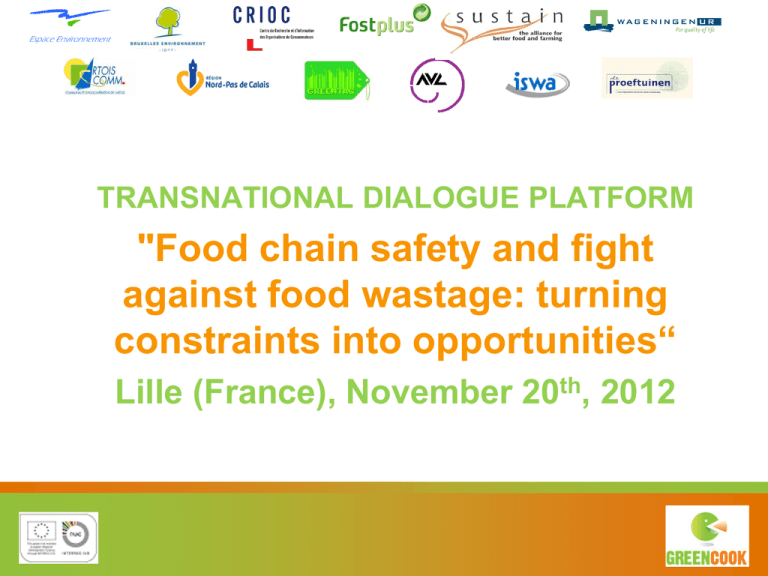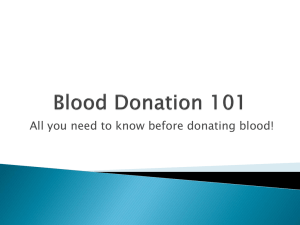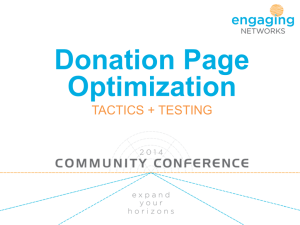LAST MINUTE MARKET
advertisement

TRANSNATIONAL DIALOGUE PLATFORM "Food chain safety and fight against food wastage: turning constraints into opportunities“ Lille (France), November 20th, 2012 Roundtable no. 1: relaxing supplier’s responsibility in order to favour donations Around the table… Dr Silvia Gaiani - University of Bologna & Last Minute Market (Italy) Thomas Pocher - Greentag/E.Leclerc (France) Serge Decaillon - Secours Populaire Pas de Calais (France) Philippe Dosogne - City of Herstal (Belgium) Serge Decaillon Secours Populaire (Pas de Calais) (France) Thomas Pocher Greentag/E.Leclerc (France) GreenTag – Developing partnership with charities in supermarkets cycle SmoothiesProduct – Methodlife of implementation Purchase by consumers Reception of goods Storage Setting on shelves Withdrawal from shelves SMOOTHIES Dumping in bigbags Organic valorization center Biogaz Compost Donation to charities Which Products are collected ? Products that are withdrawn from shelves a few days before the « Use by » or « Best before » dates Other products that are no more salable for aesthetic reasons but still edible Where ? Who ? How ? Storage area : > Waste are sorted and then are kept in a cold storage Appointment of a person responsible of donations > Data collection, monitoring indicators, contact person Definition of a monitoring method > Collection schedule, documents, traceability, indicators * Selection and meetings with associations Solidarity grocery store: They sell products at 20% of their market price. Charities : They give products for free to people in need. Photos : Lys-aux-trésors (Solidarity store) Selection and meetings with charities A list of local charities was obtained thanks to The Food Bank Organizing meetings with associations : Which products do they need ? Which equipment is available? What is their method of distribution? Defining collection days for each association Signing a partnership contract Implementation From Monday to Saturday, withdrawn products are collected by an association. They are usually redistributed during the same day. All the products are scanned by the shelf employee in order to ensure traceability and measure the donations value. Awareness and staff training is very important. Each association signs a document that list all the products collected and give the amount in number and value. Receipts are recovered from charities attesting the type and amount of donations, beneficiary’s name, date of donation. Data are compiled in an Excel© spreadsheet each month. Analysis Biowaste NET tonnage = 36,42 t (E.Leclerc Templeuve-2011) Results Huge increase since the beginning of Greencook project (Wattrelos : +700% ; Templeuve : + 1500%) In 2012 donations should also increase significantly. Evolution of donations(€P3N) Montant donné en €P3N 300,000.00 € 250,000.00 € 200,000.00 € Wattrelos 150,000.00 € Templeuve 100,000.00 € 50,000.00 € 0.00 € 2009 2010 2011 Mi 2012 2012 Projection 13 charitable partners Value of donation for 3 E.Leclerc stores : 600 000 € Donations weight : 200 tons Donation of more than 50% of total food waste Obstacles Lack of equipment of the association Cost of transport Team’s involvement Traceability and food safety Precautionary principle Philippe Dosogne City of Herstal (Belgium) Dr Silvia Gaiani University of Bologna (Italy) & Last Minute Market The Good Samaritan Law & Last Minute Market Green Cook meeting November 20, 2012 Dr. Silvia Gaiani Faculty of Agriculture Alma Mater Studiorum - University of Bologna (Italy) 19 EU Food Security: Safety Policy Food crises and scares BSE Dioxins Nitrofuran BADGE Acrylamide …. • Until 1990s: food safety is mainly a member state responsibility • White Paper on Food Safety (COM/99/719): assuring the highest standards of food safety is a key priority for the Commission; need to establish a Communitywide framework for official controls • Regulation EC/178/2002 (general food law): to protect public health and consumers’ interests in relation to food, while promoting free movement of food within the EU • Regulation EC/882/2004 (official feed and food control): sets out the approach that competent authorities of Member States must adopt for official controls EU food and feed legislation To protect the well-being of consumers, to allow them to make informed choices and to ensure free movement of goods Safety aspects •To limit amount of hazardous substances in food supply chain • To ensure that legal limits are implemented and respected Quality aspects • To ensure compliance with label declaration (content of valued ingredients, origin, manufacturing process) Measurements and legislation • Millions of measurements are performed every year to implement European legislation •Important decisions are taken based on those measurements •Need for harmonized implementation of policies • “From Farm to Fork” approach: supply chain & traceability European Food Safety Authority (EFSA) Rapid Alert Systems for Food and Feed (RASFF) EU27+ Food Safety, Food Waste and Food Donations Food safety is an integral part of managing food recovery/donations . Food recovery’ or ‘gleaning’ = collection of wholesome food from agricultural fields, retail stores, and foodservice establishments. Large quantities of wholesome, edible food are lost at every stage of the food system. By recovering perishable food from supermarkets, prepared foods from restaurants, and gleaning crops left after mechanical harvesting, a surplus of food can be saved from waste. 62 Greece 71 Malta 87 Czech Republic 89 Bulgaria 149 144 132 126 118 109 105 94 Slovenia Latvia Romania Slovakia Denmark Germany Portugal 100 France 193 184 176 171 Italy Lithuania Spain 207 Hungary 200 Finland 250 238 235 227 225 Luxembourg Austria Sweden Poland United Kingdom 264 Ireland 300 Estonia Cyprus 400 Belgium 600 Netherlands Food waste in Kg per Eu country (FAO) 700 579 500 399 334 44 0 HOW TO REDUCE FOOD WASTE? 3 Rs: reduce, reuse, recycle •EU •Waste Framework Directive (WFD) - Directive 2008/98/EC USA Food waste hierarchy EPA •Apply the “waste hierarchy” : •(a) prevention; •(b) preparing for re-use; •(c) recycling; •(d) other recovery, e.g. energy recovery; The US EPA hierarchy does not differentiate between waste treatment options; anaerobic digestion is likely to be •(e) disposal. environmentally preferable to incineration and landfilling. HOW TO REDUCE FOOD WASTE? •Food waste is expected to rise to about 126 Mt by 2020 without additional prevention policy or activities (Eurostat projections). •Source at reduction, better logistics and marketing strategies, commercial measurement and tracking software, home compost and better planning alongside municipal separated collection could all represent alternatives to food waste incineration and disposal. •Food waste recovery represents an important part of the food system, although it is NOT a solution to food waste. •In the last decade, many new initiatives whose aim is to recover food and convert it into valuable end uses, have spread all over the world. 26 Food Donation - USA 1/5 of America’s food is wasted each year. Value of lost food= $31 billion. 49 million people could have been fed by those lost resources. The Bill Emerson Good Samaritan Food Donation Act (1966) states that a person is not subject to civil or criminal liability arising from the nature, age, packaging, or condition of “apparently wholesome food”* that the person donates in good faith to a nonprofit organization for ultimate distribution to needy individuals . *food that meets all quality and labeling standards imposed by regulations even though the food may not be readily marketable due to appearance, age, freshness, grade, size, surplus, or other conditions. Food Donation - USA IMMUNITY from civil or criminal liability is regardless of who is making the claim – neither the food bank nor the ultimate consumer of the food will be able to sue to donor. The Emerson Act provides protection for food and grocery products that meet all quality labeling standards imposed by federal, state and local laws and regulations. This includes products that may not be readily marketable due to age, appearance, freshness, grade, size, surplus or other conditions. Grocery products can include nonfood products, such as disposable paper or plastic products, household cleaning products, laundry detergent, personal care items, or miscellaneous household items. Food Waste Bill - UK Labour MP for Bristol East, Kerry McCarthy, introduced in March 2012 a new Bill into the House of Commons, calling for a duty upon food retailers and manufacturers to donate their food surplus to homeless charities and, if food is unfit for human consumption, to make it available for livestock feed in preference over disposal. The Bill has not been passed Currently, the majority of food waste that cannot be recycled either goes to anaerobic digestion plants for decomposition, or to compost - with landfill as a last resort. Food Waste Bill - UK The British Retail Consortium has spoken out against the proposals, stating that a legal obligation is unnecessary in today’s climate, where the majority of food retailers and producers already see waste reduction (including packaging) as one of their corporate social responsibility objectives. It also made the point that in the UK, only 6% of food waste is produced at the supply chain end; the vast majority (over 50%) comes from households themselves. Food Donation - Italy Good Samaritan Law = Law n°155 dated 25/06/2003 "Discipline governing the distribution of food products for social solidarity purposes" It deals with the distribution of foodstuffs that can no longer be sold but that are still eatable for purposes of social solidarity, i.e. foodstuffs from supermarkets, cantines, the food industry or restaurants. It permits the distribution of surplus food to non-profit institutions (= final consumers) Food Donation - Italy When donating ,restaurateurs and retailers should • keep refrigerated items cold (5° C or below) at all times • examine the items for any signs of decay, spoilage, mold or odors • store food products separately to prevent cross contamination • discard any cut items that have not been kept refrigerated. • Food must be donated on the very same day it has been selected for donation Food waste at retailer level = 1-1,5% = 224.000 t Some Obstacles & Benefits OBSTACLES Bacteria, viruses, and parasites can grow in food if the pH, temperature, and nutrient availability are favorable. It would be better if retailers could train someone of their staff to handle the food for donation BENEFITS Retailers can spare money on landfill (normally 4% is for disposal) Retailers can spare money on VAT Charities get free food LAST MINUTE MARKET – UniBO Last Minute Market = academic spin off originated at the Faculty of Agriculture of the University of Bologna in 1999. •It links shops and producers who have unsold food (BUT NOT EXPIRED) which would otherwise be discarded with people and charities who need food (and NOT only food). •Last Minute Market’s main aim is to REDUCE food waste LMM is about logistics •Quantitative and qualitative data analysis have shown that LMM brings about environmental, economic and social benefits. •It is active in more than 40 Italian towns, with 2 new projects under development in Argentina and Brazil. 35 LAST MINUTE MARKET Stakeholders’ benefits Companies Charities Public Administration Society - Reduced disposal costs - Fiscal benefits - Better logistics - Increase visibility in the territory - Constant supply - Free food - Reinvestment of the savings - Better assistance - Reduce products in landfill - Better quality assistance - Ability to grant discounts - Better management of funds - Minor negative externalities - Education (do not waste!!) -“Ethical" behavior - Reciprocity LAST MINUTE MARKET Win-Win Strategy For profit companies Win-Win Public administration Charity organizations It provides economic, social and environmental benefits by reducing the amount of waste and improving assistance to people in need. HOW IT WORKS SELECTION OF FRUITS AND VEGETABLES FOR DONATION THE VAN OF THE CHARITY BEFORE THE DONATION THE VAN OF THE CHARITY AFTER THE DONATION PROTOCOL TO BE SIGNED LMM in Italy Recovery projects sectors • Food • Prepared meals • Gleaning • Pharmaceutical products • Books and media products • Seeds 43 projects in 12 regions ALMA MATER STUDIORUM ● UNIVERSITÀ DI BOLOGNA DIPARTIMENTO DI ECONOMIA E INGEGNERIA AGRARIE SEZIONE DI ECONOMIA E POLITICA AGRARIA Retailer case Improved efficiency on supermarket management Trend of the value and the amount of the recovered products from the supermarket LMM 1° year Year Tons € 2005 92.4 251,466 2006 61 161,339 2007 49.9 203,613 2008 53 197,828 Source: LMM data ALMA MATER STUDIORUM ● UNIVERSITÀ DI BOLOGNA DIPARTIMENTO DI ECONOMIA E INGEGNERIA AGRARIE SEZIONE DI ECONOMIA E POLITICA AGRARIA Decreasing quantity LAST MINUTE MARKET If LMM were adopted in all Italy… Stores’ Typology Expected quantities of recuperated food per year Cash and Carry shops 4.644 tonnes Superstores 67.467 tonnes Supermarkets 128.785 tonnes Small shops 43.357 tonnes TOTAL 244.252 tonnes VALUE OF RECUPERATED FOOD 928.157.600 euro = 580.402.025 meals in a year CO2 emissions 291.393 tonnes of CO2 are produced because the food end up in landfills LAST MINUTE MARKET – NOT ONLY FOOD LAST MINUTE MARKET NON FOOD FOOD SEEDS BOOK HARVEST PHARMACY LAST MINUTE MARKET – TRANSFORMING WASTE INTO RESOURCE LAST MINUTE MARKET - Achievements •Contribution to sustainability: a better management of economic, social and environmental resources •Reduction in CO2 emissions •Contribution to education on lifestyles •Benefits to the people helped by the charities: better and more nutritional food •Charities can invest the money they would have spent on food for other purposes (services) LAST MINUTE MARKET AND FOOD WASTE PREVENTION •Zero Waste is a mark issued by Last Minute Market, "certifying" the adoption of a set of tools, procedures and control systems, which provide a rational and efficient use of resources and waste management based on the principles of prevention, reuse and recycling of materials. •Zero Waste is an incentive to progressively reduce resource consumption and environmental emissions related to food waste. •It is intended for commercial, catering and collective businesses. • LMM has launched the project: A Year Against Waste is a multi-year project (2010-2014) • Aim: to raise Italian and European public awareness on the causes and consequences of waste, on how to reduce it and how to promote civic principles oriented towards sustainability and solidarity. • Topics: Food (2010), Water (2011), Energy (2012), Zero Waste (2013), European Year Against Waste (2014). • Main promoter with LMM: the Committee on Agricultural and Rural Development of the European Parliament 49 silvia.gaiani3@unibo.it www.lastminutemarket.it ww.unannocontrolospreco.org



